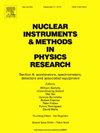Observation of acoustically silent bubble-nucleation events in superheated drop detector
IF 1.5
3区 物理与天体物理
Q3 INSTRUMENTS & INSTRUMENTATION
Nuclear Instruments & Methods in Physics Research Section A-accelerators Spectrometers Detectors and Associated Equipment
Pub Date : 2025-02-17
DOI:10.1016/j.nima.2025.170311
引用次数: 0
Abstract
A Superheated Droplet Detector (SDD) is a ubiquitous detector consisting of a large collection of micron-sized droplets of superheated liquid held in a gel matrix. An energetic particle while passing through the superheated droplet can induce a sudden liquid-vapor phase transition, which is known to be associated with the emission of an acoustic signal. An earlier experiment indicated that the amplitude of the acoustic signal decreases with increasing ambient pressure indicating that bubble nucleation may become acoustically silent at some point. This study using R1216 (C3F6) based SDD reveals that, under certain condition the spontaneous and gamma-ray induced bubble nucleation, and subsequent vaporization of superheated droplet does indeed become acoustically silent, as they are no longer detected by acoustic transducers. Here a method of detecting such acoustically silent nucleation-events is presented. These acoustically silent bubble nucleation events have been detected using an optical detection system developed in our laboratory, by which the pressure pulse created by the sudden gel-displacement during bubble nucleation is detected. A tentative explanation of acoustically silent bubble nucleation is also presented here which roughly outlines the condition for a bubble nucleation to become acoustically silent.
求助全文
约1分钟内获得全文
求助全文
来源期刊
CiteScore
3.20
自引率
21.40%
发文量
787
审稿时长
1 months
期刊介绍:
Section A of Nuclear Instruments and Methods in Physics Research publishes papers on design, manufacturing and performance of scientific instruments with an emphasis on large scale facilities. This includes the development of particle accelerators, ion sources, beam transport systems and target arrangements as well as the use of secondary phenomena such as synchrotron radiation and free electron lasers. It also includes all types of instrumentation for the detection and spectrometry of radiations from high energy processes and nuclear decays, as well as instrumentation for experiments at nuclear reactors. Specialized electronics for nuclear and other types of spectrometry as well as computerization of measurements and control systems in this area also find their place in the A section.
Theoretical as well as experimental papers are accepted.

 求助内容:
求助内容: 应助结果提醒方式:
应助结果提醒方式:


